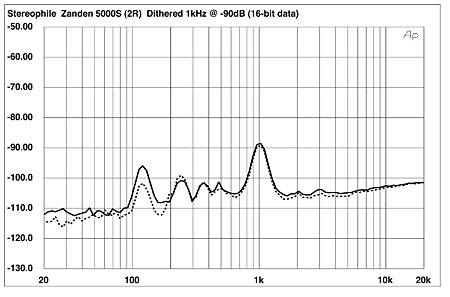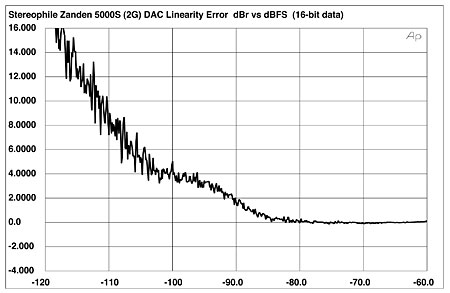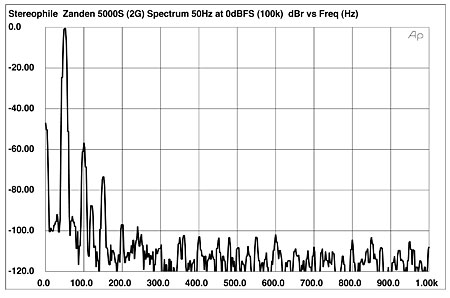| Columns Retired Columns & Blogs |
Zanden 5000 Mk.IV/Signature D/A converter & 2000 Premium CD transport Second Sample Measurements
Sidebar 5: Second Sample Measurements
When I measured the Zanden Model 5000 Mk.IV/Signature for Michael Fremer's review last month (November 2006, p.109), I was very disappointed by the performance of this $15,470 D/A processor. With its poor rejection of word-clock jitter (even when connected with an I2S link), its nonflat frequency response, its nonlinearity at low frequencies, its lack of ultrasonic image rejection, and its higher-than-usual noise floor, I described it as "the worst-measuring digital product I have encountered."
Late in the review process, Zanden's US distributor informed us that the review sample had suffered a manufacturing fault. Specifically, the polarity-inversion switch, which operates in the analog domain rather than the more usual digital domain, had been incorrectly wired so that the processor inverted absolute polarity when the LED indicator was illuminated green—the opposite of how it should behave. More important, with the switch wired in this manner, when the unit was set to preserve absolute polarity (LED illuminated red), which was how I measured it, the miswiring caused an excess of current to flow into the interstage transformer. This was the cause of both the drastic low-frequency rolloff and the very high levels of bass distortion that I found. Michael, it turned out, had done almost all his auditioning with the 5000S inverting polarity (LED illuminated green), when it should have performed rather better.
Zanden immediately FedExed a new sample of the 5000S to me, but it arrived too late for me to measure it in time for the November issue, hence this Follow-Up.
The serial number of the original review sample of the 5000S was 023; that of the new sample was 0706055. All tests were performed driving the Zanden's AES/EBU input with a link from the RME soundcard fitted in my PC. The left channel of the original Zanden 5000S put out a maximum of 1.6V at 1kHz; the second sample's left channel was a little hotter, at 1.814V. Like the first sample, the second's right channel was around 0.5dB higher in level. The output impedance was significantly lower, at 333 ohms at 1kHz, compared with 2.5k ohms.
The first sample's frequency response when set to the correct polarity was disappointing, with a noticeable rolloff of low frequencies that reached –3dB at 65Hz and –9dB at 24Hz. The second sample was flat to below 10Hz into a high 100k ohms load (fig.1, top traces below 100Hz), with only a slight bass rolloff apparent into the punishing 600 ohm load (fig.1, bottom traces). The response was identical with the DAC set to invert polarity, but the top octave still rolled off a little prematurely.

Fig.1 Zanden 5000S, inverted polarity, frequency response at –12dBFS into 100k ohms (top), with de-emphasis (bottom). (Right channel dashed, 1dB/vertical div.)
As with the first sample, the second sample's noise floor was higher than I usually find with 16-bit DACs, as can be seen from the spectral analysis of the 5000S's analog output while it decoded data representing a dithered 1kHz tone at –90dBFS (fig.2). This graph was taken with the unit set to the correct polarity, and relatively high AC-supply components can be seen at 120Hz and 240Hz in both channels, though the 60Hz component seen in the first sample's left channel is missing. Curiously, inverting signal polarity reduced the level of the AC supply spuriae (fig.3). As in the first sample, the Philips TDA1541 DAC chip features increasingly positive linearity error below –80dBFS (fig.4). This was unaffected by the setting of the polarity switch.

Fig.2 Zanden 5000S, correct polarity, 1/3-octave spectrum with noise and spuriae of dithered 1kHz tone at –90dBFS (right channel dashed).

Fig.3 Zanden 5000S, inverted polarity, 1/3-octave spectrum with noise and spuriae of dithered 1kHz tone at –90dBFS (right channel dashed).

Fig.4 Zanden 5000S, left-channel departure from linearity, 16-bit CD data (2dB/vertical div.).
The new 5000S was very much better than the first at reproducing high-level low-frequency tones with low distortion. Whereas the original produced more than 20% of multiple distortion components with a full-scale 50Hz tone, even into the benign 100k ohm load, the new sample produced a much more acceptable 0.15% in both polarity conditions. Even better, this was predominantly the second harmonic (fig.5), which the ear tends to tolerate. Again, the 120Hz AC-supply component decreased with the 5000S set to invert polarity.

Fig.5 Zanden 5000S, correct polarity, spectrum of 50Hz sinewave at 0dBFS into 8k ohms (linear frequency scale).
However, the second Zanden 5000S's behavior on the high-frequency intermodulation test was still disappointing, with a relatively high second-order difference product and a large number of audioband intermodulation and aliasing products visible (fig.6). And I was still disappointed by the Zanden's rejection of word-clock jitter. The original had produced almost 4.4 nanoseconds peak–peak of word-clock jitter when driven by its AES/EBU input; the new sample produced 4.9ns in correct absolute polarity, 4.7ns in inverted polarity. Again, the jitter-related sidebands were almost all related to the low-frequency component of the test signal (fig.7).

Fig.6 Zanden 5000S, correct polarity, HF intermodulation spectrum, 19+20kHz at 0dBFS peak into 8k ohms (linear frequency scale).

Fig.7 Zanden 5000S, high-resolution jitter spectrum of analog output signal, inverted polarity (11.025kHz at –6dBFS sampled at 44.1kHz with LSB toggled at 229Hz), CD data. Center frequency of trace, 11.025kHz; frequency range, ±3.5kHz.
Regarding the manufacturing defect suffered by our original review sample of the Zanden 5000S, the second sample was free from this problem, and offered very much better low-frequency linearity and a much lower output impedance. Other than the slight difference in hum, its performance was basically the same in both inverting and noninverting polarity conditions. However, its digital-domain performance is still rather old-fashioned, particularly regarding word-clock jitter rejection and low-level linearity error. An enigma.—John Atkinson
- Log in or register to post comments



































